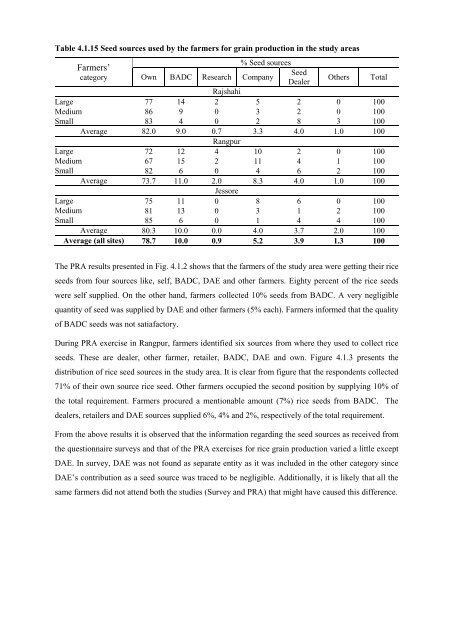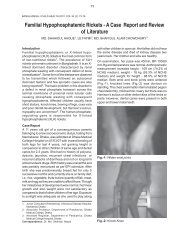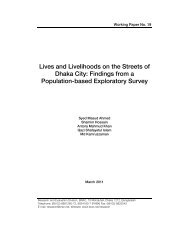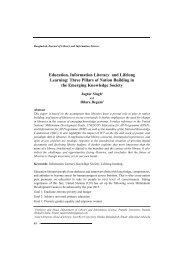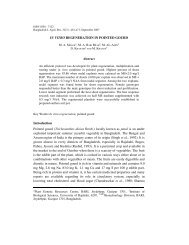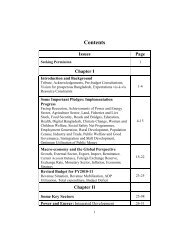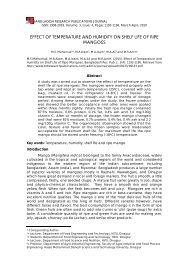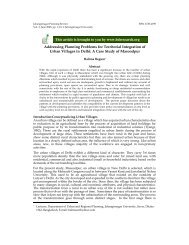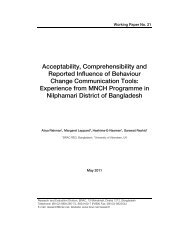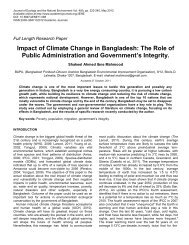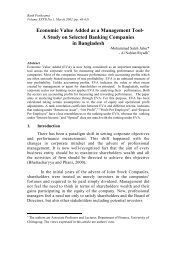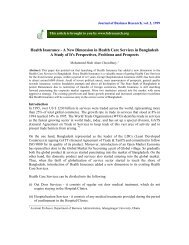Studies on Policy Option for Quality Seed Production and ... - NFPCSP
Studies on Policy Option for Quality Seed Production and ... - NFPCSP
Studies on Policy Option for Quality Seed Production and ... - NFPCSP
Create successful ePaper yourself
Turn your PDF publications into a flip-book with our unique Google optimized e-Paper software.
Table 4.1.15 <strong>Seed</strong> sources used by the farmers <strong>for</strong> grain producti<strong>on</strong> in the study areasFarmers’category% <strong>Seed</strong> sourcesOwn BADC Research Company<strong>Seed</strong>DealerOthersRajshahiLarge 77 14 2 5 2 0 100Medium 86 9 0 3 2 0 100Small 83 4 0 2 8 3 100Average 82.0 9.0 0.7 3.3 4.0 1.0 100RangpurLarge 72 12 4 10 2 0 100Medium 67 15 2 11 4 1 100Small 82 6 0 4 6 2 100Average 73.7 11.0 2.0 8.3 4.0 1.0 100JessoreLarge 75 11 0 8 6 0 100Medium 81 13 0 3 1 2 100Small 85 6 0 1 4 4 100Average 80.3 10.0 0.0 4.0 3.7 2.0 100Average (all sites) 78.7 10.0 0.9 5.2 3.9 1.3 100TotalThe PRA results presented in Fig. 4.1.2 shows that the farmers of the study area were getting their riceseeds from four sources like, self, BADC, DAE <strong>and</strong> other farmers. Eighty percent of the rice seedswere self supplied. On the other h<strong>and</strong>, farmers collected 10% seeds from BADC. A very negligiblequantity of seed was supplied by DAE <strong>and</strong> other farmers (5% each). Farmers in<strong>for</strong>med that the qualityof BADC seeds was not satiafactory.During PRA exercise in Rangpur, farmers identified six sources from where they used to collect riceseeds. These are dealer, other farmer, retailer, BADC, DAE <strong>and</strong> own. Figure 4.1.3 presents thedistributi<strong>on</strong> of rice seed sources in the study area. It is clear from figure that the resp<strong>on</strong>dents collected71% of their own source rice seed. Other farmers occupied the sec<strong>on</strong>d positi<strong>on</strong> by supplying 10% ofthe total requirement. Farmers procured a menti<strong>on</strong>able amount (7%) rice seeds from BADC. Thedealers, retailers <strong>and</strong> DAE sources supplied 6%, 4% <strong>and</strong> 2%, respectively of the total requirement.From the above results it is observed that the in<strong>for</strong>mati<strong>on</strong> regarding the seed sources as received fromthe questi<strong>on</strong>naire surveys <strong>and</strong> that of the PRA exercises <strong>for</strong> rice grain producti<strong>on</strong> varied a little exceptDAE. In survey, DAE was not found as separate entity as it was included in the other category sinceDAE’s c<strong>on</strong>tributi<strong>on</strong> as a seed source was traced to be negligible. Additi<strong>on</strong>ally, it is likely that all thesame farmers did not attend both the studies (Survey <strong>and</strong> PRA) that might have caused this difference.


